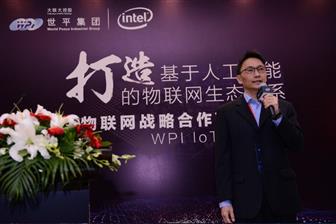IoT is poised to become the backbone supporting the operation and technological development of vertical markets around the world. However, IoT applications are becoming fragmented as they are being used by a wide range of different industries. To consolidate upstream and downstream demands for IoT applications, global leading CPU manufacturer, Intel launched the "Intel IoT Solution Aggregator" initiative in hopes of leveraging channel operators' professionalism and local networks to drive IoT promotion. WPI, targeting semiconductor component markets in Asia for years, has been chosen as one of the world's few Intel IoT Solution Aggregators for its solid strength in semiconductor technology and application. Through the aggregator role and its own partnership programs with system integrators, WPI will be able to help system integrators and enterprises needing IoT applications quickly bring IoT systems into reality.
In explaining what Intel IoT Solution Aggregators mean to the market, Dennis Niu, vice president, IoT solutions department, WPI, notes, "A slew of IoT applications are being developed, including smart city, smart retail and smart manufacturing. The market is also seeing all types of artificial intelligence (AI) development kits to enable IoT solution development. However, these development kits need to be consolidated with the solutions to be able to meet market demand. This is what led to the Intel IoT Solution Aggregator initiative, aimed to help system integrators find suitable target users for their IoT solutions."
IoT solutions enabled by aggregators can use Intel certified Market Ready Solutions (MRS) or RFP Ready Kits (RRK, an IoT development toolkit) to develop. According to Niu, MRS targets end users in specific industries. It has a full range of functions and mature architecture which are already market proven. It allows IoT applications to be up and running with only slight modifications by the user. RRK, on the other hand, targets system integrators with R&D capabilities. It can help system integrators design tailor-made IoT systems to suit specific needs.
Both end users and system integrators can leverage Intel's MRS and RRK to quickly build IoT systems that meet their requirements. However, there are more challenges to overcome for these solutions to be put to practical use. For example, the convergence of information technology (IT) and operational technology (OT) can be an issue, said Niu. This is where WPI's valuable experience accumulated through years of market operations comes into play. Its deep understanding of the field enables WPI to help enterprises remove the obstacles one by one and get the system up and running. For example, WPI recently helped a large aquafarm operator in Taiwan build an IoT environment control system, which has also been successfully promoted to WPI customers in Southeast Asia.
Aside from helping enterprises with its professional know-how, WPI is also closely working with system integrators to address the issue that IoT systems are overwhelmingly large and the IoT application market is strongly characterized by having a small quantity and large variety of solutions as well as requirements so an individual developer can hardly satisfy market needs by itself. As an aggregator, WPI brings together partners specializing in different links in the IoT industry chain to jointly build up a diverse ecosystem.
Further to offering professional services and building an ecosystem, WPI is committed to refining its technological strength. With rising popularity of AI and the combination of AI concepts with Internet of Things (IoT) infrastructure, the scope and depth of AIoT applications are catching market attention. In view of this, Intel introduced the Intel OpenVINO platform, which is an open source tool to help developers conduct AI training, targeting machine vision applications. According to Hung-Cheng Lin, associate manager, smart connection, IoT solutions department, WPI, Intel OpenVINO features high flexibility and quick development while supporting common deep learning frameworks including Caffe and TensorFlow. WPI's own AI lab combined with the flexibility of Intel OpenVINO can help firms quickly develop AI solutions suited to their needs. It frees enterprises from having to choose a hardware architecture. They only need to focus on their own R&D. For example, an AI-enabled digital signage can detect a viewer's gender, age and emotion and accordingly display a suitable advertisement to deliver precise marketing. It can also monitor the surroundings and issue an alert in the case of a fire.
In summary, with IoT applications being inherently fragmented, enterprises do not want a single device or system but a total solution. Through its aggregator role and partnership programs with system integrators, WPI has successfully built up a complete IoT ecosystem, which will allow governments and firms in Asia to share their successful experiences and quickly bring demand-side IoT applications to reality.

Both end users and system integrators can leverage Intel's MRS and RRK to quickly build IoT systems that meet their requirements." says Dennis Niu, vice president, IoT solutions department, WPI
DIGITIMES' editorial team was not involved in the creation or production of this content. Companies looking to contribute commercial news or press releases are welcome to contact us.
